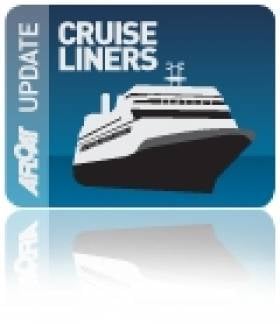Displaying items by tag: Galway Cruise callers
#RoyalConnections - Amadea anchored off Galway Harbour today is a fleetmate of the former Royal Princess named by the late Princess Diana of Wales and where yesterday Prince Charles visited the Marine Institute in Oranmore, Co. Galway, writes Jehan Ashmore.
The Amadea (1991/29,000grt) with 624 passengers is the second of seven callers due off Galway Harbour this season. The Japanese built cruiseship is operated Pheonix Reisen for the German market which is served also by Albatros and Artania (with an interim name of Artemis) having been launched as Royal Princess in 1984.
Last August during a call on Galway Bay, the Finnish built Artania required additional capacity to tender passengers ashore using Aran Island Ferries, Glór na Farraige (Voice of the Sea).
Only last week, Glor na Farraige, the 244-passenger ferry was chartered by the ships agent of the current Royal Princess which anchored offshore of Dun Laoghaire on her maiden port of call to the Dublin Bay harbour.
When the first Royal Princess entered service she was 44,000 tonnes and the difference compared to her namesake successor is stark considering the cruiseship is some 100,000 tonnes larger. This second Royal Princess has 3,600 passengers and built in Italy. She entered service in 2013 and was christened by the Catherine, Duchess of Cambridge.
A second scheduled visit off Dun Laoghaire for this Sunday is understood to be cancelled, however the Royal Princess will continue to call to Dublin Bay albeit by docking instead in Dublin Port.
It is not known why Princess Cruises is understood to be changing port to that of neighbouring Dublin, though conditions at sea involving anchorage can present a variety of factors not necessary due to weather when determining decisions.
Last year the weather had in this case proved too much which led to cancellation of the 51,044 tonnes Crystal Symphony, as the bad weather prevented tendering ashore. As previously reported on Afloat.ie instead she headed for Cobh.
The Galway Harbour Company have plans to redevelop the city's port with a new outer deepwater harbour in which An Bord Pleanála had a hearing into the €126 million scheme.
In the meantime, Galway Harbour can look forward to a further five cruiseships during the season.





























































